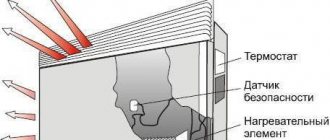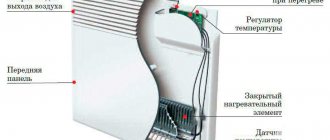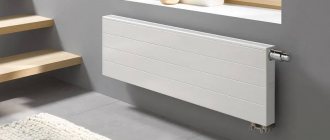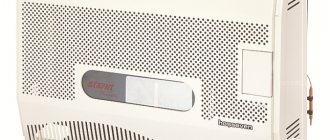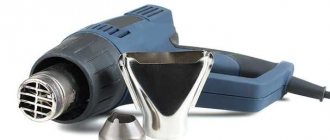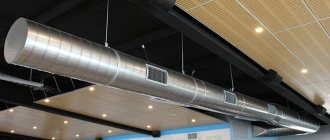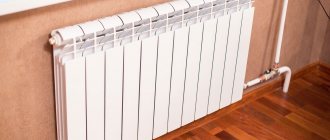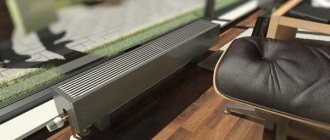Here you will learn:
- Calculation of convector power by area
- Calculation of convector power by volume
- Energy Saving Tips
- Auxiliary heating calculation
By choosing convector heaters to heat your home, you are making an excellent choice. This equipment is highly efficient, allowing you to heat residential premises for any purpose. But before buying, you need to work with the numbers to calculate the number and power of devices. Calculating the power of a convector is not as complicated a process as it might seem at first glance. And in this review we will present you with two formulas for correct calculation.
Calculation of convector power by area
The wrong choice of convectors can lead to a lack of heat or unnecessary financial costs. The lack of the required amount of heat is caused by a lack of power - as a rule, this is the result of incorrect calculation. As for large expenses, they are caused by the purchase of convectors with too much power reserve, which in some cases is completely useless.
A simple table for determining the power of a convector.
The easiest way is to calculate the power of convectors based on the area of the premises. The standard formula is used here, according to which for 10 sq. m of living space requires 1 kW of thermal energy . In the northern and Far Eastern regions, where winters are colder than anywhere in central Russia, there is 1.5 kW of heat per 10 square meters. We will start from the initial value of 1 kW.
Having studied the formula for calculating the power of convectors by area, you can independently calculate the required power of the equipment, based on the requirements for heating equipment for your region.
In order to make the process of calculating the power of convectors more visual, let’s imagine that we need to heat a household with an area of 100 square meters. m. with a ceiling height of 2.5 meters. Based on the indicated formula, we will need heaters with a total area of 10 kW. The main task is to distribute them among heated rooms so that each room is as warm as the neighboring rooms.
In these calculations, we do not take into account the heat losses that are present in heated rooms. They need to be used in the process of calculating the power of convectors by area. Here are the most important coefficients:
- Lack of insulated walls - a coefficient of 1.1 is applied;
- Single-layer double-glazed windows - a coefficient of 0.9 is applied;
- Two external walls (corner room) - use a coefficient of 1.2;
- Ceiling heights from 2.8 to 3 meters - we use a coefficient of 1.05.
The most accurate power calculations take into account the wind rose, the ratio of window area to floor area, the presence of an entrance door, etc. That is, the required power may be higher than the specified value - if single-layer double-glazed windows are installed in the premises, the power of the equipment should be increased by 10% ( not counting other possible leaks).
Table for calculating the power of convectors taking into account the thermal insulation of the room.
By performing an accurate and competent calculation, you can create an effective heating system based on convectors.
Operating principle and classification
The design of the device for generating heat is quite simple: a housing, air ducts, a heating element, and connection equipment. The principle of operation is also straightforward: cold air from the environment enters the device. With the help of additional devices, it is heated and released out through a hole at the top of the device.
To save energy and maintain optimal temperature, room heaters are equipped with temperature sensors. The main advantage of convectors over similar heat sources is safety. The temperature on the device body remains no higher than +60°C.
In this video you will learn how to choose a heater:
Classification of convectors:
- by mode of action (water, electric, gas);
- by type of fastening (floor, wall, universal);
- according to the design of the heating element (monolith, heating element, needle).
See also: installation of convectors built into the floor.
The advantage of gas convectors compared to water heaters is their independence of operation from low temperatures. The disadvantages include the significant dimensions of the installations and increased explosion hazard. The best choice for heating apartments and cottages is electric convectors.
Convectors differ, at a minimum, in the method of mountingCalculation of convector power by volume
You already know how to calculate the power of a convector, taking into account the area of the premises. But some experts believe that it is best to calculate by their volume. To do this, use the formula according to which per 1 cubic meter. m. volume requires 40 W of heat . The main advantage of this formula is that it is the most accurate, since it fully takes into account the height of the ceilings.
The process of calculating the power of convectors by volume is carried out as follows:
- We take a tape measure and measure the room;
- We calculate the volume of the room by multiplying the obtained values by each other;
- Multiply the volume by 0.04 (40 W per 1 cubic meter);
- We get the recommended thermal power.
A more clear example - let's try to calculate the power of convectors for a room 3 m long, 2.5 m wide and 2.7 m high. Its volume is 20.25 cubic meters. m, therefore, the power of the convector heaters used should be 0.81 kW (feel free to buy a 1 kW model). If we make similar calculations for the area, the recommended figure will be 0.75 kW.
As in the case of calculating the power of convectors by area, it is necessary to take into account in the calculations possible heat losses that may be present in any room.
Summary table of units of measurement
| Physical quantity | Non-systemic unit | SI unit | Transition from a non-systemic unit to an SI unit |
| Activity of a nuclide in a radioactive source | Curie (Ci) | Becquerel (Bq) | 1 Ci = 3.7⋅1010 Bq |
| Exposure dose | X-ray (R) | Coulomb/kilogram (C/kg) | 1 P = 2.58⋅10−4 C/kg |
| Absorbed dose | Glad (glad) | Gray (J/kg) | 1 rad = 0.01 Gy |
| Equivalent dose | rem (rem) | Sievert (Sv) | 1 rem = 0.01 Sv |
| Exposure dose rate | Roentgen/second (R/s) | Coulomb/kilogram (in) second (C/kg s) | 1 R/s = 2.58⋅10−4 C/kg s |
| Absorbed dose rate | Rad/second (Rad/s) | Gray/second (Gy/s) | 1 rad/s = 0.01 Gy/s |
| Equivalent dose rate | rem/second (rem/s) | Sievert/second (Sv/s) | 1 rem/s = 0.01 Sv/s |
| Integral dose | Rad-gram (Rad g) | Gray kilogram (Gy kg) | 1 rad g = 10−5 Gy kg |
Energy Saving Tips
Our houses lose a lot of thermal energy. In order not to overpay for electricity, just get rid of heat loss.
By making calculations based on area or volume, and not taking heat losses into account at all, you risk getting an insufficiently efficient heating system - the rooms will be cool. The worst thing is if severe frosts hit in winter, which are not very typical for this area - if the calculations were made incorrectly, the convectors will not cope.
Next, we will tell you how to reduce heat loss. The banal lining of the household with an additional layer of brick and thermal insulation will help reduce them by 10-15%. Yes, the costs may be high, but you must remember that when using electric convectors, the costs of light can be gigantic - this is associated with large heat losses (in fact, you are heating the air “outside”).
You also need to work on the windows:
- Single-glazed windows require a 10% increase in power;
- Double windows do not lead to any heat loss (already a plus);
- Triple windows can save up to 10%.
In theory, three-pane windows can lead to significant savings, but there are other factors to consider.
During the insulation process, it is necessary to work in the attic. The whole point is that having an unheated attic entails losses. Therefore, you need to lay a layer of effective thermal insulation on it - it is not very expensive, but you can save up to 10% of thermal energy. By the way, the figure is 10%, based on the area of the house of 100 square meters. m, this is approximately 24 kW of heat per day - equivalent to monetary costs of 100 rubles / day or 3000 rubles / month (approximately).
How can you save money?
It is, of course, unreasonable to completely abandon the benefits of modern life, but in order to save money, you can pay attention to energy-saving refrigerators, because this device will work all year round, regardless of weather conditions. If you calculate how much energy a TV and computer consume per month, you can completely influence this amount by choosing one working device
Often, a switched-on monitor works all day without any benefit, and a running TV becomes the background against which we carry out everyday activities. Getting rid of such habits is not easy, but within a month it will give results in the form of a reduced energy bill.
Other methods to save electricity:
Replace all lighting fixtures with new energy-saving or LED lamps. The initial investment will pay off handsomely with serious savings and a long service life. If you use an electric kettle frequently, always add only as much water as needed, and not in reserve. Unfortunately, energy-saving kettles have not yet been invented, but it is entirely within your power to adjust the mode of use. Place your computer in comfortable standby mode. In this case, it turns off automatically if a certain amount of time passes without operation.
When turned on, it will accordingly consume less energy, which is also important. Defrosting the refrigerator and freezer on time is also part of family savings. When a significant amount of ice forms on the walls, energy consumption increases, so be sure to eliminate this factor. The use of heat-reflecting screens will help make heaters and convectors work more efficiently. Replacing wiring and organizing local lighting in the kitchen or recreation area will also significantly reduce costs. The use of adapters and extension cords increases energy consumption. When purchasing new electrical appliances, it is better to give preference to the economical consumption class
The main positions are shown in the table.
One of the less common ways to save electricity is the installation of multi-tariff meters. This will allow you to turn on some appliances at night, when electricity costs less. This practice has shown itself to be excellent in foreign countries, but unfortunately, it has not yet taken root here.
It is probably impossible to completely abandon the use of electrical appliances in the modern world. Even a gas boiler and heating convector must consume a certain amount of energy to function. If we are talking about a welding machine, boiler or air conditioner, the consumption is significant even with short-term use. Despite this, consumers are buying more and more different electrical appliances, so it would be useful to find out the main “culprit” of electricity bills, as well as proven methods of reasonable savings that will help reduce costs.
Auxiliary heating calculation
If the house already has centralized heating, then no convectors are needed here. But if the heating system works very poorly, you should take action - we use convector heaters as auxiliary equipment. It will be very easy to calculate the required power - it is equal to half the power of full heating. For example, for an apartment of 100 square meters. m. 5 kW convectors will be required.
In a similar way, you can calculate by volume - count the convectors for the entire area based on the formula 20 W per 1 cubic meter. m.
Temperature controller type
The regulator in the control unit is designed to automatically maintain the room temperature. Based on the readings of the sensor installed in the lower part of the convector body, the regulator turns the heating element on and off when the set temperature is reached.
There are two types of temperature controllers:
- mechanical;
- electronic.
Types of regulator
The mechanical regulator is made on the basis of a step switch and has the most simple design. The disadvantage of mechanical control is low accuracy with an error of 1-3 degrees, as well as low reliability. When the mechanically controlled heater is turned on, a distinct click of the relay is heard.
Mechanical control unit
The advantages of this type of switches include resistance to voltage surges in the network. If a mechanical regulator fails and fails, it can be quickly and inexpensively replaced.
Convector with mechanical thermostat
The electronic control unit is a more complex device that allows you to set the temperature with an accuracy of 0.1 degrees, as well as different modes of use: night, day, plus temperature maintenance mode. The heater switches on and off silently. Electronic regulators are often equipped with an LCD display that displays the room temperature, as well as mode parameters when programming it.
LCD display on electronic control unit
Electronic regulators are generally more reliable, but they fail when the voltage drops by 15-20% of the nominal value. Repairing and replacing an electronic unit is expensive, so it is better to install the device together with a voltage stabilizer or a protective voltage relay.
Electric convector JH-heater
Electric convector Electrolux ECH/AG-500MF
Heating system options
So, let's look at existing equipment that will make electric heating in the house economical and cheap.
Using the boiler
Installing an electric boiler, which will heat water in the home heating system, warming up the room, is the first, least effective option. Of course, on the Internet you can see a bunch of information that talks about economical boilers that can reduce consumption by up to 80%, but all this is nonsense. The only option to reduce costs is to install thermostats and various automation systems, which will turn on only when the temperature in the room drops, as well as at certain times of the day. All other talk about new product designs or reduced power is just a publicity stunt. If you buy a small-power boiler, it will take more time to heat the water for heating the house, so that’s what it will do.
Using IR Panels
Installing infrared heaters is a more reasonable solution and, most likely, the most profitable. The fact is that these products do not heat the air in the room, but certain objects (floor, walls, closet), from which heat is subsequently transferred. If in the previous version the hot air will rise to the ceiling and immediately cool down, then in this case the heat is directed to the floor, which is more reasonable (people do not walk on the ceiling).
This diagram shows the efficiency of an economical heating system for a private home:
You see everything for yourself, so there is nothing more to prove. It should only be noted that IR devices can work more efficiently if you add thermostats to them. One regulator is enough to control three heaters in an economical heating system for a private home. We talked about how to connect a thermostat to an infrared heater in a separate article.
Using convectors
Many manufacturers convince us that an electric convector effectively heats a room and at the same time consumes a small amount of electricity. The issue is of course controversial, because, in fact, the principle of operation of the products is similar to the option with radiators (the air rises upward). The advantage of convectors is that their installation and connection are not difficult. In addition, heating of the heating element takes about one minute, which is undoubtedly faster than in the case of water radiators.
Other advantages of electric convectors include:
- low cost (from 2 to 10 thousand rubles);
- fire safety (which is especially important when installing heating in a wooden house);
- you can gradually increase the heating system (one convector for a room is not enough, buy another one and connect it to the network without any problems);
- attractive appearance;
- trouble-free operation during power surges (also important in the private sector);
- compact sizes.
Separately, I would like to recommend that you explore a heating option such as electric heated floors. You can find out a review of this heating system by watching the video:
Application of heated floors
We analyzed reviews from customers who used this option and saw that most people were satisfied with the purchase. The main thing is to additionally install a temperature regulator in order to make economical electric heating in the house with your own hands.


